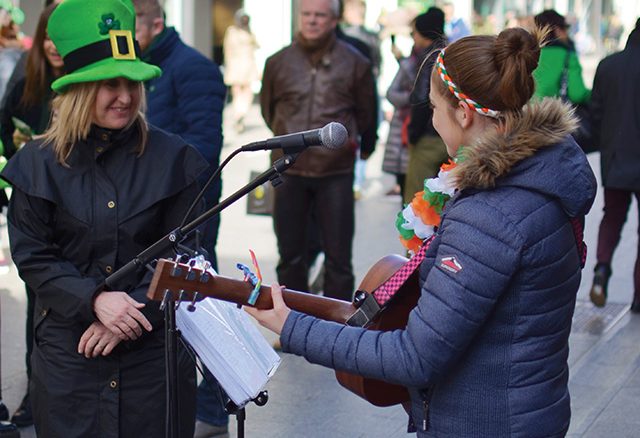
A new wave of young buskers have taken over the streets of Dublin. Competing for peak times and areas could cause busking wars but they are all part of a supportive community, says singer songwriter KK Lewis.
The nation’s capital has played a part in launching many an artists career. Singer/songwriter Paddy Casey, Academy Award winner Glen Hansard, Key West and Damien Rice have all performed on Grafton Street, perhaps the most famous Dublin busking spot, over the years.
As well as the typical one man (or woman) and a guitar setup, the city has many traditional Irish musicians, street performers and of course the occasional living statue.
Dublin’s rich and diverse busking scene really helps to define the city and shows both locals and tourists the extent of the talent and culture it has to offer.
KK Lewis who began busking last January talks about what encouraged her to start it up. It was “meeting other buskers which made me realise music was possible,” she explains.
Lewis had been interested in music since she was a kid. However since leaving secondary school it has become her life. She takes to Dublin streets four days a week (weather permitting of course) as well as performing in venues like Workmans, Sin É and Smock Alley Theatre.
Busking allows her to meet people from all over the world and become part of a large community.
According to Lewis making friends isn’t too hard when you’re out in the city all day. “You just start chatting while you’re queuing for spots and we’re all very close,” she says.
Busking has launched many young musicians’ careers in the past and given them a platform to share their work without needing a record label backing. But now busker’s act as their own publicist and manager thanks to social media.
Due to Facebook, Instagram, YouTube and many other social media sites the busking landscape has changed dramatically.
Buskers now have a huge online presence. Just look at Allie Sherlock, a 13-year-old singer/songwriter originally from Cork who has over 2 million subscribers on YouTube.
Sherlock gained a massive online following after a video of her performing on Grafton Street went viral.
As a result, the teenager appeared on The Ellen DeGeneres Show in the US and has signed a five year contract with American record label Tedder at the start of 2018.
Sherlock of course is a rare case but many other young buskers in Dublin have large social media followings that are growing by the day, particularly on Instagram.
Performer, Buzz Apollo Music has over 3000 followers on his Instagram page. Another busker, Paul Jenkinson, has close to 8,000 Instagram followers and Lewis herself has a following of over 4,000.
These musicians share a lot of their street performances on their social accounts, giving their music a much wider reach than buskers of the past. People can see them perform without even having to be there and they can update their followers with any upcoming gigs or new music.
It is also clear from looking at all their accounts, community and collaboration is key when busking in Dublin city in 2019.
These buskers will often share videos or photos of them performing with others. It’s a wonderful thing to see, as you see the friendship as well as the professionalism between young talented musicians.
But what about the more traditional buskers? Máire Ní Bheaglaoich who began busking in Dublin in 1985 seems hesitant about the large amps and electric setups used by some modern buskers.
“Industrial-scale amps and industrial busking with karaoke-like equipment has been drowning out the acoustic, live, local music from the past.” Ní Bheaglaoich, who plays the concertina, told District Magazine.
Busking in Dublin is regulated by the Dublin City Council. In 2015, they brought in revised busking bye-laws that have significantly changed the busking scene.
The new regulations allowed for amplifiers to be used in more areas across the city as well as new rules surrounding permits.
However, a major change was that performers could only stay on Grafton Street for one hour at a time.
This has allowed a queuing system to develop which according to Lewis works very well. She explains that the performers are patient and accept that they must wait for their turn.
Many of Dublin’s buskers are writing their own music as well as performing covers. Busking is not just a hobby but a real career prospect.
Thanks to her busking career and following the release of her first single Flowers over the summer, Lewis is now working on her EP. Her second single will also be released in the new year.
Busking isn’t the easiest career path, particularly in Ireland. There can be miserable days where the rain just won’t clear so performers go home with their pockets a bus fare lighter.
But it is also a wonderful way to showcase young Irish musicians. The cacophony of noise that fills Grafton street on a sunny summers day is wonderful to hear and it adds soul to even the most commercial of Dublin’s streets.
Aoibhín Meghen
Image Credit: Sonja Tutty


